
Energy Secretary Praises Lab Research During Visit
Journey to the Center of the Earth, 2005
Energy Secretary Praises Lab Research During Visit
Secretary of Energy Samuel Bodman’s first time at Berkeley Lab wasn’t just a visit; it was, he said, “a pilgrimage.”
Bodman, a chemical engineer from MIT, told an audience on August 5 that “the exploits of the people who started this lab are very well known. Your work and that of your predecessors really helped create this country in fundamental ways.” And he called Berkeley the “lead horse” among the Department of Energy’s national labs.
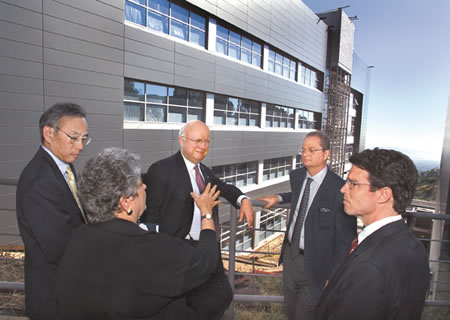
Secretary Bodman (center) is flanked by Lab Director Steve Chu and Associate Lab Director Paul Alivisatos during his visit to the Molecular Foundry construction site. Facing them are M.R.C. Greenwood, the senior vice president for Academic Affairs and provost of the UCOP and Jim Krupnick, project management officer at Berkeley Lab.
That was even before he spent 90 minutes on a tour with briefings on key Laboratory initiatives. Laboratory Director Steve Chu hosted Bodman and his aides, including Office of Science Director Ray Orbach, during what was the Secretary’s final stop on a whirlwind tour of DOE science labs, finishing with the three Bay Area labs in three days.
Addressing an attentive audience at an all-hands meeting in the Building 50 auditorium, Bodman spent some time emphasizing the importance of research done at Berkeley Lab. “[This work] is crucial to the American economy,” he told emp-loyees. “Without you, we wouldn’t be performing anywhere near what we have done economically. I am a great believer in what you do.”
A veteran of national political leadership (he was deputy secretary of both the departments of Treasury and Commerce), Bodman said he “found surprising” the range of research activities that go on here. “They seem to cover the waterfront,” he said, also noting Berkeley Lab’s recent achievement of three R&D 100 Awards for technical innovation. “Your total (37) ranks up at the top of institutions across the country.”
His message of praise was tempered, however, by a note of caution about both funding and educational trends in science and engineering — downward trends that he said he hoped to help reverse through raising the profile of science in Washington.
He also emphasized what he called his “hot button”issue — worker safety. “The (most) important issue for the management of our labs is not the technology, the budget, or the buildings. It is the people — their quality and their capability. I am very focused on the safety of the people who do the work you do. If there is the slightest letup in paying attention to what is required (in safety), problems will occur. You are the most important asset you have here. Look after each other.”
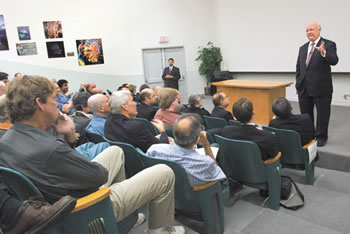 Energy Secretary Bodman addressed a large crowd in the Building 50 auditorium during an all-hands meeting on August 5.
Energy Secretary Bodman addressed a large crowd in the Building 50 auditorium during an all-hands meeting on August 5.
Bodman, who has been in his current position just since January, fielded audience questions about the energy cost and supply crisis, carbon sequestration research, and nuclear waste disposal. Carefully and patiently, while seated casually on the front of the stage table, he explained the Administration’s views on each.
The rest of his day, which had started with a stop at the Stanford Linear Accelerator Center and then a Commonwealth Club address, was dedicated to learning more about some of Berkeley Lab’s highest research priorities — high-performance computing and modeling, supernova and dark energy studies, cell imaging and protein crystallography at the Advanced Light Source, nanotechnology and the Molecular Foundry, and genetics and computational biology.
At the computing stop in the grid room of Building 50, mathematicians John Bell and Phil Colella joined Division Director Horst Simon in illustrating the importance of computer simulation to research advances. They used as an example Bell’s recent work in turbulent pre-mixed combustion of low-swirl burners, a subject of special interest for Bodman in relation to clean-burning fuels and emissions. Simon stressed the continuing need for DOE’s National Energy Research Scientific Computing Center (NERSC), which Berkeley Lab manages, to increase its speed and capacity in order to confront such complex problems.
Then on to astrophysicist Saul Perlmutter’s presentation on the SuperNova/Acceleration Probe (SNAP), which Chu described as a key to making “the discovery of the 21st Century” — the true nature of the mysterious forces of “dark energy.” To build and launch the satellite, the Secretary was told, will take a joint commitment from the DOE and NASA.
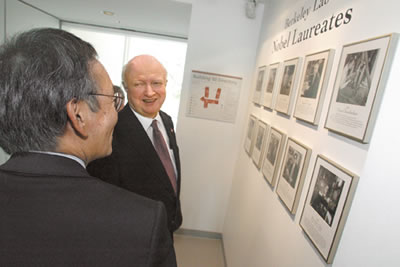 Director Steve Chu (left) and Secretary Bodman stopped by the Nobel Laureates display in Building 50 during Bodman’s tour of Berkeley Lab.
Director Steve Chu (left) and Secretary Bodman stopped by the Nobel Laureates display in Building 50 during Bodman’s tour of Berkeley Lab.
Before he entered the ALS for demonstrations by life scientists Carolyn Larabell and Paul Adams, Bodman paused on the patio and, looking out at the dramatic two-bridge view of the Bay, quipped, “If you’re forced to work someplace, this is a good place to work.” ALS acting Director Janos Kirz described the characteristics and usage of the light source and led a birds-eye tour across the machine’s inner structure.
Associate Laboratory Director Paul Alivisatos took over at the National Center for Electron Microscopy, reviewing the Laboratory’s plans for nanoscience and, in particular, how NCEM and the Molecular Foundry will contribute to America’s search for new and more efficient energy sources. While overlooking the Foundry’s construction site, Bodman was told by University of California Provost M.R.C. Greenwood, visiting from the Office of the President, that the program illustrates the unique pairing of campus with laboratory in leveraging resources and talent. “No other research university in the world can do that for you,” she told him. “I think you are seeing the beginning of a whole new era.”
Energy and environmental remediation were the subjects of a final briefing on biology with Associate Laboratory Director Joe Gray, Gene-tics Division Director Eddy Rubin, Chu, and Deputy Director Graham Fleming. Bodman thanked his hosts and expressed his pleasure at all he had seen — a pilgrimage fulfilled.
Journey to the Center of the Earth, 2005
In his nineteenth century novel Journey to the Center of the Earth, Jules Verne imagined the route to the Earth’s core ran through an extinct volcano in Iceland. An alternative route, running through a mine cavern in Japan, has been discovered by an international collaboration of scientists at the KamLAND neutrino detector. The KamLAND researchers have shown that antielectron neutrinos emanating from the Earth, or geoneutrinos, can be used as a unique window into the interior of our planet, revealing information that is hidden from other probes.
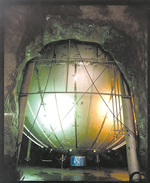 KamLAND is the first neutrino detector used to identify and measure geoneutrinos.
KamLAND is the first neutrino detector used to identify and measure geoneutrinos.
“This is a significant scientific result,” said Stuart Freedman, a physicist with Berkeley Lab’s Nuclear Science Division and a co-spokesperson for the U.S. team at KamLAND. “We have established that KamLAND can serve as a unique and valuable tool for the study of geoneutrinos with wide-ranging implications for physical and geochemical models of the Earth.”
In a paper in the July 28 issue of the journal Nature, the collaboration of 87 authors from 14 institutions in four nations reported the ability of the KamLAND detectors to accurately measure the radioactivity of uranium and thorium isotopes, the two main sources of terrestrial radiation. These measurements were in close agreement with the predictions of the leading geophysical models of our planet’s thermal activities.
Surprisingly, for all that we have learned about far distant astrophysical events such as deep-space supernovae, dark energy, or even the Big Bang, the interior of our own planet remains a mysterious and largely unexplored frontier. Among the many questions is the source of terrestrial heat. The Earth’s conductive heat flow has most recently been estimated at about 31 tera-watts (TW). Much of this heat is re-radiated energy from the sun, but nearly half is produced from the Earth’s interior. Radioactivity is known to account for some of this heat, but exactly how much has been difficult to say because, until now, there has been no accurate means of measuring radiogenic heat production. These latest experimental results from KamLAND could change that.
“Our results show that measuring the flux of Earth’s geoneutrinos could provide scientists with an assay of our planet's total amount of radioactivity,” said Freedman. “Measuring geoneutrinos could also serve as a deep probe for studying portions of the planet that are other-wise inaccessible to us.”
KamLAND stands for Kamioka Liquid scintillator Anti-Neutrino Detector. Located beneath the mountains of Japan’s main island of Honshu near the city of Toyama, it is the largest low-energy anti-neutrino detector ever built. KamLAND consists of a weather balloon filled with a liquid scintillator that emits flashes of light when an incoming anti-neutrino collides with a proton. These light flashes are detected and converted into electronic signals that computers can analyze. The photomultipliers are attached to the inner surface of a stainless steel sphere and separated from the balloon by a buffering bath of inert oil and water, which helps suppress interference from background radiation.
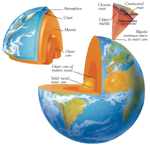 Geoneutrinos, anti-electron neutrinos emanating from the Earth, are expected to serve as a unique window into the interior of our planet.
Geoneutrinos, anti-electron neutrinos emanating from the Earth, are expected to serve as a unique window into the interior of our planet.
Neutrinos and their antimatter counterpart, anti-neutrinos, are subatomic particles that interact so rarely with other matter that they can pass untouched through a wall of lead stretching from the Earth to the moon. Neutrinos are produced during nuclear fusion, the reaction that lights the sun and other stars. Anti-neutrinos are created in fission reactions, such as those that drive nuclear power plants, and in radio-active nuclei, such as uranium and thorium, which emit an electron and an anti-electron neutrino when they decay.
Anti-neutrinos, like neutrinos, come in three different types, or “flavors” — electron, muon and tau, with the anti-electron neutrino, or geoneutrino, being by far the most common. Geoneutrinos can be detected and measured at KamLAND via a distinctive reaction signature after the subtraction of anti-neutrinos captured from nearby reactors and in background events from alpha particles.
“KamLAND is the first detector sensitive enough to measure geoneutrinos produced in the Earth from the decay of uranium-238 and thorium-232,” said Freedman. “Since the geoneutrinos produced from the decay chains of these isotopes have exceedingly small interaction cross sections, they propagate undisturbed in the earth’s interior, and their measurement near the Earth’s surface can be used to gain information on their sources.”
By measuring geoneutrinos generated in the decay of natural radioactive elements in the Earth's interior, scientists believe it should be possible to get a three-dimensional picture of the Earth's composition and shell structure. This could provide answers to questions such as how much terrestrial heat comes from radioactive decays, and how much is a "primordial" remnant from the birth of our planet. It might also help identify the source of Earth’s magnetic field, and what drives the geodynamo.
The Secrets Behind Movie Magic
"Jumping off the roof of a building is the easiest job in the world,” said Steve Wolf, a special effects coordinator during his presentation at the Lawrence Hall of Science (LHS) on August 10. “The stuntperson gets all the money, gravity does all the work.”
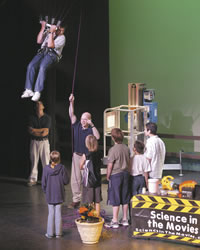
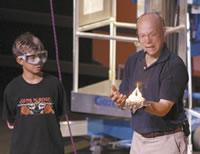
And gravity gets some help from science. That’s what has kept Wolf busy in the movie business for the past 16 years, designing and performing stunts and special effects for feature films and TV shows such as The Firm, The Jungle Book and Cast Away.
Wolf recently took his one-man show, "Science in the Movies,” to both the LHS and the Amador Theater at Lawrence Livermore National Laboratory. The event was co-sponsored by Berkeley Lab’s Physics Division, the LHS, and Livermore Lab.
Wolf had the packed LHS crowd in the palm of his hands with live demonstrations of pulleys that allow you to lift people several times your weight (left); fires that can be controled with valves in burning houses (made of metal); and the use of a special gel that can keep not only stuntmen but also firefighters cool and safe (right).
The shows, part of the two Labs’ celebration of the International Year of Physics, were fun for the kids, but also educational.
"What [the children] are exposed to at school is like putting them to sleep," Wolf said. "I wanted to make learning as exciting as action-packed movies."
-- Monica Friedlander
‘Roadrunner’ Still Rounding Bases After 25 Years
It was the spring of 1981 when Oliver Morse finally succumbed to the desperate pleadings of his Facilities Division colleague Steve Blair, who worked in the cubicle next to his in Building 90.
“Every day, I could hear this guy on phone, begging people to join his Lab softball team,” says Morse, an electrical engineer who retired in 1995. “I couldn’t take it anymore, so one day I leaned over the partition and told him I would play.”
That was nearly 25 years ago, and Morse is still hitting, throwing, and running for Blair’s team, Sudz, at the age of 72. Sudz is one of six teams in the Lab’s softball league, which competes every year during the summer months.
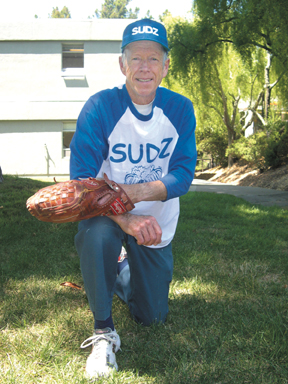 Now retired, Oliver Morse is still hitting, throwing, and running for the Sudz at the age of 72.
Now retired, Oliver Morse is still hitting, throwing, and running for the Sudz at the age of 72.
“Our team name back then was the B90 Bombers, after our building number,” Morse says. “But the title was a little too apt. We lost every game. When we changed our name to Sudz the next year, things started turning around.” (Morse’s favorite team name, he recalls, was Infrared Sox, an opponent that has since disbanded.)
It’s only natural that Morse would join the softball league, since he’s played nearly all his life. He participated in sandlot baseball as a kid, and in intramural leagues as an undergraduate at Yale and doctoral student at UC Berkeley. In between, he served in the Army, and later, while working for the National Bureau of Standards, was sent to Antarctica to run their Ionosphere program.
Morse started in the Plant Engineering Division (now called Facilities) in 1977, and later moved to the Energy and Environment Division (now Environmental Energy Technologies).
The camaraderie between Sudz team members as well as their laid-back philosophy has kept Morse — nicknamed Roadrunner for his speedy base-running capabilities — coming back year after year, even after retirement.
“We don’t get yelled at for messing up. We try to have as much fun as possible,” he says. “One of our top priorities is to put a major dent in the beer and pizza supplies of La Vals, where we go for post-game celebrations.”
Much further down the list, says Morse, who specializes in right and center field and is a back-up pitcher, is the business of playing softball. This attitude suits him just fine.
“If I drop dead of a heart attack during a game, I want to be dragged off the field, then have players continue. No need to stop just because I expired,” he says with a grin. “Then there should be a big party afterwards.”
Large NCI Grant Goes to Lab, UCB Researchers
How does a living cell’s DNA become polluted with genetic errors that can lead to the development and spread of cancer? A key factor is the transcription process, whereby the coded information contained in a cell’s genome is translated into the production of proteins. To shed more light on the biological mechanisms underlying this process, the National Cancer Institute (NCI) has awarded a five-year, $8.5 million grant to a team of Berkeley Lab and UC Berkeley researchers.
“We will launch a coordinated and interdisciplinary effort to determine the three-dimensional structures of key transcription complexes and unravel the mechanisms that regulate gene transcription in human and animal cells,” said molecular biologist Robert Tjian, who holds joint appointments with Berkeley Lab’s Physical Biosciences Division and is also a professor at UC Berkeley and an investigator with the Howard Hughes Medical Institute (HHMI).
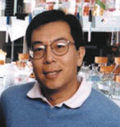 Robert Tjian
Robert Tjian
Tjian is one of three principal investigators leading the projects covered under this grant. The others are Eva Nogales, a biophysicist who also holds joint appointments with Berkeley Lab, UC Berkeley and HHMI, and Berkeley Lab Director Steven Chu. Tjian will oversee a detailed structural and functional analysis of the transcriptional factor (TF) proteins TFIIA and TFIID, which help initiate and regulate the transcription of protein coding genes. Nogales will head an effort to develop new and improved cryo-electron microscopy and single particle image analysis for the study of TFIID and other transcription activator/co-activator protein complexes. And Chu will use the technique known as single molecule fluorescence resonance energy transfer (FRET) to observe transcriptional components as they interact with one another.
“A major component of this grant will be the establishment of a biochemistry and core protein laboratory to serve as the nerve center and clearinghouse for generating the many cell lines, expression clones, protein complexes, and purification strategies to be used by each of the three projects under this grant,” said Tjian. “Our goal is to apply distinct and complementary research strategies to dissect the core machinery responsible for gene control leading to cancer.”
The biological machinery that conrols the growth, development, division and the eventual death of living cells starts with transcription. In preparation for protein production, a strand of DNA from a cell’s genome is unwound and unzipped. At that point, various components of the transcription complexes will undertake to “read” the DNA, identify and bind to the genes, then interact with RNA polymerase so that the genetic code is transcribed into messenger RNA. Some of these transcription components form multi-subunit complexes. Tjian, Nogales and Chu are looking to build a comprehensive understanding of the function and structure of these multi-subunit complexes.
A Future Paved with Hydrogen
Berkeley Lab group receives $4.5 million to develop hydrogen storage materials
Someday, hydrogen-fueled cars could zip along America’s highways. Hydrogen fueling stations could be as ubiquitous as today’s gas stations. And petroleum-sputtering cars could be as quaint as the horse and buggy.
Sounds great, but a future with zero-emission vehicles powered by a renewable source of energy will not happen unless scientists overcome several daunting technological hurdles. Among them: can enough hydrogen be stored aboard a car to power fuel cells for hundreds of miles without refueling?

 Jeff Long is working to develop nanoporous solids in which exposed metal sites capture hydrogen molecules under less extreme temperatures and pressures.
Jeff Long is working to develop nanoporous solids in which exposed metal sites capture hydrogen molecules under less extreme temperatures and pressures.
“Pressurized hydrogen cylinders take up a lot of volume in a car. They don’t leave much room for luggage if you want to drive 300 miles without refueling,” says Jeff Long of Berkeley Labs Materials Sciences Division. “Hopefully, that will change, but for now it is difficult to store a lot of hydrogen in a small volume without cooling it or placing it under very high pressure.”
Long heads a group of nine scientists who are investigating new classes of materials that can efficiently store hydrogen aboard cars under less extreme temperatures and pressures. The team is among the recipients of $64 million in DOE funding aimed at making hydrogen fuel cell vehicles and refueling stations available, practical and affordable for U.S. consumers by 2020. The funding was announced in May by Secretary of Energy Samuel Bodman and is divided among 70 R&D projects at more than 50 institutions.
Their project will receive $4.5 million in DOE funding over the next four years. Another Lab project, headed by Lutgard DeJonghe of the Materials Sciences Division, also received DOE funding to ex-plore the development of nanocomposite proton conductors, which are used in hydrogen fuel cells.
For his project, Long assembled a materials sciences dream team of leading experimentalists and theoreticians. Like Long, most of them hold joint appointments at Berkeley Lab and UC Berkeley’s departments of chemistry or physics. Paul Alivisatos will examine how hydrogen storage properties change with a material’s size, from the nanoscale to the bulk scale. Martin Head-Gordon will help predict what kinds of metals and ligands bind to hydrogen. Jean Frechet, a polymer scientist, will try to create nano-porous polymers that absorb hydrogen onto tiny cavities. Alex Zettl, a pioneer in developing nanotubes, will explore how boron nitride nanotubes can be used to store hydrogen. Theoreticians Marvin Cohen and Steven Louie will predict new boron nitride nanostructures that can more efficiently capture hydrogen. UC Berkeley’s Tom Richardson will synthesize and characterize metal hydrides. And to test these new materials, UC Berkeley’s Samuel Mao will set up instrumentation that measures hydrogen uptake under a range of temperatures and pressures.
“The idea is to get people who are highly skilled in materials development to start thinking about the hydrogen storage problem,” says Long.
For his part, Long is working on a storage material that has an incredibly large surface area enfolded into a small amount of space. Called a nanoporous coordination solid, some materials of this type boast 4,500 square meters of surface area per gram, meaning it has the potential to store a lot of hydrogen. The trick is getting hydrogen molecules to bond to the framework without having to cool it to low temperatures or expose it to high pressures.
“So far the affinity of the hydrogen is too weak, so our goal is to increase the binding energy by creating the framework from new ma-terials,” says Long. “We’re making progress, but we’re still at the very early materials-discovery stage.”
Harnessing Wind Energy in Eritrea
At the southern tip of the Red Sea, a constriction formed between two mountain ranges funnels wind onto the shores of Eritrea, a small African nation wedged between the sea and Ethiopia. The country has endured its share of hardships over the years, having won its independence from Ethiopia in 1991 after decades of struggle. But it can count among its blessings that relentless breeze.
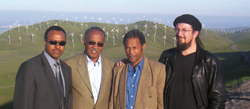 Abiy Ghebremedhin, project manager for Eritrea Wind Energy Project (left), Abraham Woldemichael, director of Eritrea Electric Corporation, Debessai Gebrehiwot, director of the Energy Research and Training Center, and Berkeley Lab’s Robert Van Buskirk visit the Altamont pass. Photos by Robert Van Buskirk
Abiy Ghebremedhin, project manager for Eritrea Wind Energy Project (left), Abraham Woldemichael, director of Eritrea Electric Corporation, Debessai Gebrehiwot, director of the Energy Research and Training Center, and Berkeley Lab’s Robert Van Buskirk visit the Altamont pass. Photos by Robert Van Buskirk
“It’s a wind resource that is better than most wind resources in the U.S.,” says Robert Van Buskirk, a Berkeley Lab scientist who develops cost-benefit analysis models of energy policy. Earlier this summer, he spent four weeks in Eritrea to help the nation embark on a $3.8 million pilot project to determine whether a large portion of its energy can be derived from wind-powered turbines. Berkeley Lab has been contracted to help Eritrea create the most efficient procedures for implementing wind energy systems, as well as develop protocols that track the project’s progress.
It’s a big undertaking for a nation with a population of 4.5 million and an average annual income of $250 per person. The United Nations and an international consortium of donors called the Global Environmental Facility funds half of the nine-month-old project, while the Eritrean government provides the other half. But money isn’t the only obstacle.
“The barriers are mostly technical. We need to determine how to develop sustainable contracts between the people of Eritrea, companies that develop wind energy systems, and technical advisers,” says Van Buskirk, a member of the Environmental Energy Technologies Division’s Energy Analysis Program. “Getting these worlds to meet in an economically feasible way is difficult,” he adds.
In the project’s initial phase, engineers will soon install eight wind energy systems in eight villages, some of which have never had electricity. These wind turbines will be used to pump irrigation water, provide electricity for everyday use such as lighting and making ice, and power desalinization plants that provide fresh drinking water to seaside fishing villages. Engineers will also build a multi-turbine wind park that feeds into the electricity grid of the southern port of Assab.
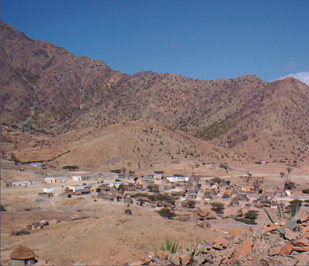 Remote Eritrean villages stand to gain the most from the diffusion of wind energy technologies.
Remote Eritrean villages stand to gain the most from the diffusion of wind energy technologies.
“In diffusing wind technology to Eritrea, we want to pilot test an array of applications because we won’t know which ones will work best,” says Van Buskirk.
Berkeley Lab scientists are also developing conceptual designs for six follow-up installations which include more expansive wind energy systems for remote villages, and a larger wind-park for the central grid.
Ultimately, Eritrean officials would like to generate as much as 50 percent of the nation’s grid electricity via wind power. It’s too early to tell whether this goal is technically feasible, but Van Buskirk believes it may be economically viable. He estimates that wind energy will pay for itself in five years if it supplants Eritrea’s thirst for foreign fuel oil, now its main energy source for generating electricity. The nation has worked to be as self reliant as possible since gaining independence, meaning it must find alternatives to imported oil.
Van Buskirk is uniquely qualified to help shepherd this transition along. Before joining Berkeley Lab in 1999, he worked for three years at the Eritrean Department of Energy’s Energy Research and Training Center, which he describes as the Eritrean equivalent of Berkeley Lab, albeit in one small compound. While there, he helped establish research programs in wind and solar energy resource assessment and stove efficiency.
This latter program has evolved into another energy efficiency project. Eritrean villagers are adopting clean-burning cooking stoves that are three times more fuel efficient than traditional stoves. Lab scientists are developing ways to document the economic and health imp-acts of this program, which installs up to 10,000 new stoves each year.
Van Buskirk has also helped several Eritrean students earn master’s degrees in meteorology from San Jose State University. Two of them have recently developed computer simulations that assess the wind resources of Eritrea’s highlands and southeastern coast.
 Eritrean officials hope to someday provide as much as 50 percent of the nation’s grid electricity using wind turbines, such as these located near Palm Springs, California.
Eritrean officials hope to someday provide as much as 50 percent of the nation’s grid electricity using wind turbines, such as these located near Palm Springs, California.
“I’m a communication bridge between this world and that world,” says Van Buskirk, adding that language and cultural barriers sometimes pose challenges. “When I go to some remote villages to discuss our work, a local staff member translates my words into the Eritrean language of Tigrinya, then a person from the village translates it into a local dialect, called Tigre.”
Such hurdles are easily justified, however, as remote villages stand to gain the most from new technologies. In rural areas that have never seen electricity or running water, projects that raise living standards while decreasing labor often pay for themselves in less than one year.
“It’s an extreme case study in technology diffusion. We start with a place that is a world research leader like Berkeley Lab, and go to a place that is the largest socioeconomic distance from that, which is rural Africa,” says Van Buskirk. “The difficult part is learning how to adapt technologies to a socioeconomic world far removed from our everyday life. We need to create a context in which people can sustain efficient energy systems over the long term. And in terms of evaluating and creating long term sustainability, we find that the villagers, rather than the scientists, are the real experts.”
Other Berkeley Lab scientists and staff involved in the wind energy pilot project and stove replacement project include Bill Golove and Chris Bolduc, also of the Environmental Energy Technologies Division.
A Gold Mine for Science
There’s “gold in them thar hills!” Scientific gold that is. In the ponderosa pine-cloaked Black Hills of South Dakota, outside the town of Lead, lies the Homestake gold mine, the deepest mine in the United States and the site of the single largest gold deposit ever found in the western hemisphere. Now emptied of all its precious metals and abandoned, Homestake is poised to become the home of an enormous underground multipurpose national scientific laboratory.
The National Science Foundation has announced that the Homestake gold mine is one of two finalists in the competition to determine the future location of the Deep Underground Science and Engineering Laboratory (DUSEL). The Homestake underground lab proposal, which is being led by Kevin Lesko, a nuclear physicist with Berkeley Lab’s Nuclear Science Division, will receive a $500,000 grant from NSF to go forward with a conceptual design for DUSEL.
 The Homestake gold mine in Lead, South Dakota, now closed, is the deepest mine in the United States and was the site of the single largest gold deposit ever found in the Western Hemisphere. Scientists believe there is still much “gold” to be mined there in the form of new data over a broad range of research.
The Homestake gold mine in Lead, South Dakota, now closed, is the deepest mine in the United States and was the site of the single largest gold deposit ever found in the Western Hemisphere. Scientists believe there is still much “gold” to be mined there in the form of new data over a broad range of research.
“The Homestake mine is a vast site capable of hosting a comprehensive suite of experiments in all major fields of science, including low background experiments and very large detectors in particle and nuclear physics, and multidisciplinary deep subsurface studies in geosciences, geoengineering and microbiology,” said Lesko. “Furthermore, with 375 miles of tunnels already carved, the Homestake site could be expanded over the next 30 years to accommodate an evolving scientific and outreach mission.”
A broad number of scientific investigations need to be carried out underground — the deeper the better. For example, a number of questions important to the fields of astrophysics and astronomy cannot be answered unless experiments are shielded from cosmic rays and other background radiation by thousands of feet of rocks. And prominent among the experiments that require the ultralow backgrounds realized at great depths are studies of the elusive, ghostlike subatomic particles known as neutrinos.
“Homestake will house the full spectrum of today’s neutrino laboratories at one site,” Lesko said.
Other astrophysical research planned under the Homestake Underground Laboratory proposal include studies of gravity and of dark matter, the mysterious form of matter that is invisible to our current means of detection, but whose ubiquitous presence throughout the universe has been indirectly confirmed.
Said Lesko, “Homestake could also host very large multipurpose physics detectors for detecting proton decay, one of the longest-lived unanswered questions in non-accelerator physics.”
In other studies, scientists will get a closer than ever look at the earth’s crust and new opportunities for monitoring the movement of groundwater. They will also be able to examine the unique biochemistry of organisms that thrive under heat and pressure conditions which would be deadly to surface dwellers. Carbon sequestration efforts — the idea of safely burying global warming gases like carbon dioxide underground — should also receive a significant boost.
The Homestake Underground Laboratory proposal calls for a two-level facility; an upper level that will serve research operating from the surface to a depth of 4,850 feet, and a lower level facility which would descend to nearly 8,000 feet.
Other Berkeley Lab researchers who are contributing to the development of the Homestake Underground Laboratory proposal include James Symons of the Nuclear Science Division, Hitoshi Murayama and William Chinowsky of the Physics Division, Bo Bodvarsson and Joseph Wang of the Earth Sciences Division, and Kem Robinson, head of the Engineering Division.
Berkeley Lab Opens Arms to Summer Students
They came from all over the country and even the world again this summer — high schoolers, undergrads, graduate students and even teachers — enriching Berkeley Lab with their presence and enthusiasm and taking back with them an experience that could shape the rest of their lives. More than 150 students and teachers participated in the various educational opportunities offered by Berkeley Lab.
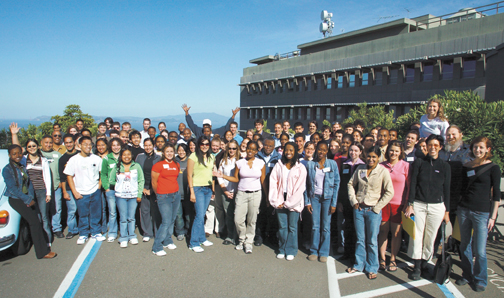
Students who participated in a variety of educational programs at Berkeley Lab this summer gathered outside of Building 50 back in June to celebrate the beginning of their internships.
“The summer of 2005 has been one of the most successful years for our mentored research experience programs in the over 20 years that I have been involved in these outreach activities,” said Rollie Otto, head of the Lab’s Center for Science and Engineering Education, which organizes most of these educational programs. “A primary factor has been the overwhelming support from the investigators at Berkeley Lab who serve as mentors in these programs.”
Many of the divisions, science programs and investigators sponsored students with their own program funds, Otto added. More than 200 scientists and support staff served as mentors and teachers.
The programs, which lasted from 6 to 12 weeks, included:
- The Science Laboratory Undergraduate Internship Program, for college undergraduates
- The High School Student Research Participation Program, for high school juniors and seniors
- The Community College Institute of Science and Technology, for community college students, mostly from California
- The Preservice Teacher Program, for college undergraduates planning to teach science or mathematics (organized in partnership with CSU Fresno)
- The Laboratory Science Teacher Professional Development Program, for middle school, high school and community college faculty
- The Faculty Student Teams Research, designed for faculty from colleges and universities with limited research facilities and institutions serving populations underrepresented in the fields of science, engineering, and technology
- The Louis Stokes Alliance for Minority Participation Bridge to Ph.D. program, for four graduate students from Jackson State University
High Schoolers in the Spotlight
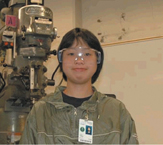
Lili Fang from Oakland Technical High School worked under the supervision of Seno Rekawa in the Center for X-Ray Optics. She was one of 37 interns who participated in the six-week High School Student Research Participation Program for high school juniors and seniors. The students concluded their internships on August 12 with presentations held in the Building 50 auditorium.
Posters Tell the Story
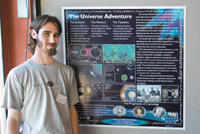
Paul Higgins (right) could not have dreamt up a better summer internship. For 10 weeks he was able to integrate his twin passions for physics and graphic design while working at Berkeley Lab under the mentorship of renowned scientists such as George Smoot and Michael Barnett. Along with three fellow students, he helped develop the Universe Adventure website (universeadventure.com), a project that was first started a couple of years ago. A student at Contra Costa College, Higgins will transfer to UC Berkeley in the fall to pursue a double major in physics and astronomy.
Higgins is one of 72 future scientists who participated in the Science Laboratory Undergraduate Internship Program, sponsored every year by Berkeley Lab’s Center for Science and Engineering Education. Students worked in teams with other interns and Lab mentors.
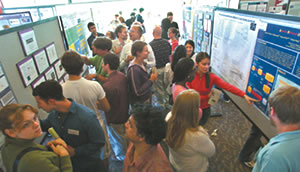
On August 9 the students presented the results of their work in a poster session held at the cafeteria. Their work touched on virtually every topic of research being conducted at Berkeley Lab, from fundamental nuclear science and breast cancer research to studies of indoor air quality and computing systems cryptography.
Nuclear Science at the 88-Inch Cyclotron
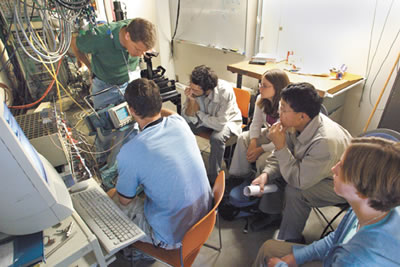
Physicist and science education specialist Peggy McMahan ran a summer school for graduate students who will lead the next generation of nuclear science experiments. The program for 48 graduate student research assistants from around the country and Europe featured experiments at the 88-Inch Cyclotron.
People, Awards, and Honors
First Safety Recognition Awards Handed Out
The Environment, Health and Safety Division has initiated an award program to recognize individuals whose initiative has resulted in improving safety at the Laboratory. The awards, administered through the Spot Award program, are awarded by a committee made of members from both EH&S and the divisions. The first 10 winners, listed below, were selected from among 24 nominees.
Their contributions ranged from making suggestions that will improve road safety to taking leadership in ensuring a safe work environment.
Future nominations may be made through division safety coordinators, and will be reviewed on a quarterly basis.
Award winners
- Teresa Lynem, Chemical Sciences
- Christophe Nicolas, Chemical Sciences
- Marcus Hertlein, Chemical Sciences
- Musahid Ahmed, Chemical Sciences
- Mike Jimenez Cruz, Chemical Sciences
- Wayne Lukens, Chemical Sciences
- Ed Romero, Engineering
- Bryan Holmes, Engineering
- Micheele Galloway, Nuclear Sciences
- James Osborn, Engineering
Lab Computing Group Wins UCOP Award
Berkeley Lab's Scientific Cluster Support (SCS) program, housed within the Information Technology Division, was awarded the Larry L. Sautter Silver Award for Innovation in Information Technology by the UC Office of the President. The award was presented on August 8 during the annual UC Computing Services Conference in San Francisco. Project director Tammy Welcome and project lead Gary Jung also presented a talk on the program to spur collaboration with UC partners at the conference.
In Memoriam
Bea Singer
Bea Singer, a senior scientist in the Life Sciences Division and a UC Berkeley Emeritus Research Biochemist, died on July 20 after a brief illness. She was 82.
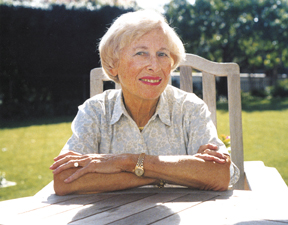
Singer joined Berkeley Lab in 1985 after retiring from a nearly 40-year career in UC Berkeley’s Department of Molecular Biology. She maintained an active, funded research program until the end of her life.
She was widely recognized for her early work that elucidated RNA structure and function of the plant RNA virus TMV, which she conducted in partnership with her late husband Heinz Fraenkel-Conrat. Subsequently she contributed to the field of chemical carcinogenesis and mutagenesis, including work on DNA alkylation damage and the formation and repair of cyclic adducts in DNA by a major class of occupational carcinogens.
A resident of Berkeley for 65 years, Singer was active in civic affairs and was a past president of the League of Women Voters. She is survived by her daughter, son, and five grandchildren. A memorial event is being planned for the fall.
Tasuya Nakae
Tatsuya “Tats” Nakae, a retired mechanical engineering associate, passed away on July 21 due to complications of lung cancer at the age of 78. He had worked in the Engineering Division from 1953 until his retirement in 1989.
Born on June 25, 1927 in Newcastle, Calif., Nakae served in the U.S. Army Air Corps from 1945 to 1946. He was educated at Armstrong Technical College and UC Berkeley as a mechanical designer before embarking on his long career at Berkeley Lab. He was an avid bowler and car affictionado.
Nakae is survived by his wife Masako, sons, Jeff and Les, daughter Marta, and a granddaughter. Donations may be sent to the Standing Guard project, Sierra College, Rocklin, Calif., the Alta Bates Cardiac Rehabilitation Center in Berkeley, or the Neptune Society of Northern California. A memorial service will be held on September 10 at 4 p.m. at the Berkeley Methodist United Church.
Berkeley Lab View
Published twice a month by the Communications Department for the employees and retirees of Berkeley Lab.
Reid Edwards, Public Affairs Department head
Ron Kolb, Communications Department head
EDITOR
Monica Friedlander, 495-2248,
msfriedlander@lbl.gov
STAFF WRITERS
Dan Krotz, 486-4019
Paul Preuss, 486-6249
Lynn Yarris, 486-5375
CONTRIBUTING WRITERS
Jon Bashor, 486-5849
Allan Chen, 486-4210
David Gilbert, (925) 296-5643
Photography
Roy Kaltschmidt, 486-5731
Creative Services Office
FLEA MARKET
486-5771, fleamarket@lbl.gov
Berkeley Lab
Communications Department
MS 65, One Cyclotron Road, Berkeley CA 94720
(510) 486-5771
Fax: (510) 486-6641
Berkeley Lab is managed by the University of California for the
U.S. Department of Energy.
Online Version
The full text and photographs of each edition of The View, as well as the Currents archive going back to 1994, are published online on the Berkeley Lab website under “Publications” in the A-Z Index. The site allows users to do searches of past articles.
Flea Market
- AUTOS & SUPPLIES
- ‘03 TOYOTA ECHO, sport model, auto, dual fr airbags, ac, am/fm/CD, 40K mi, exc cond, $1,1500, Ingrid, X4118
- '00 TOYOTA CAMRY, 4 cyl, auto, pwr, 36K mi, silver, good maint, $9,500, Zhang, X5573, 663-2910
- ‘98 CHRYSLER SEBRING CONVERT JXI, 82K mi, drk green, V6, loaded, good running cond, some cosmetic defects, $3,700/bo, 1 owner, nonsmok, stored in garage, Julia, 333-2700
- ‘84 VOLVO 240DL WAGON, manual trans, 181K mi, runs great, sec owner, all records, blue w/ blue int, $1,700, Dariush, X6844, 653-7188 (h)
- ‘79 MERCEDES BENZ 240D, 4 dr, low mi, runs exc, minor dent in driver’s side dr, $1,800/bo, 467-9586
- HOUSING
- BERKELEY, 2 bdrm/1 bth, cable ready, newly painted/carpeted home, offstr parking, priv porch, laundry rm, nr Marina/trans/shopping, $1,200/mo, 981-9918, bsols@yahoo.com
- BERKELEY, studio inlaw apt, sep ent, quiet, near shops/rest/BART, walk to campus, w&d, incl water, garbage, 12-mo lease, no pets/smok, $575/mo, Linda, 849-1579, lmoroz@earthlink.net
- BERKELEY HILLS, 1 bdrm, comb kitchen/liv rm, 1 bth w/ w&d, hardwd flrs, own ent & small deck, fully furn, free broadband connection, walk to Lab, bus stop, avail 9/1, 4-mo min lease, $1,200/mo+gas & elec, Henrik, 848-2202, wallman@berkeley.edu
- BERKELEY HILLS, 2 bdrms in house on Grizzly Pk nr Avenida, avail 9/1, close to Lab, cute, wood-shingled house, great bay views, nr Tilden Pk, hardwd flrs, deck, fp, cherry kitchen cabinets, wireless internet, gas stove, dw, w&d, space for gardening, see photos.yahoo.com/smurtishaw, 1 rm is $900, 11x14, priv bthrm, other rm $550, 10x11, share bthrm w/ one other housemate, Scott, X7553, 644-2723
- EAST BAY HILLS, rm to share in new home on 10-acre horse property, peace & quiet, great views, wildlife, great kitchen, fun family, 15 min to BART/ hwys, trail access to Briones Pk, pasture/stall boarding avail for add’l cost, outdoor dog or cat possible, no smok/ drugs, responsible pers only, $750/mo, incl util except long dist, avail immediately, Nancy, X5102
- EL CERRITO, 2 bdrm/1 bth, alarm, priv garage, 2 laundry rms, balc, well main priv yard, exc quiet neighbrhd, nr shopping/BART/I-80, 1,265/mo+ $1,800 sec dep, E.R. Anderson, 724-3089, panda5622@ aol.com
- OAKLAND, Glenview dist, off Hwy 13, 2 bdrm home, $1,595/mo, dcphillips@lbl.gov
- SAN LEANDRO, 2 bdrm/2 bth condo, ground flr, new carpet, $1,200/mo + sec dep, Bob, X6162, 357-2778
- HOUSING WANTED
- LONG TIME HOUSING needed in Berkeley for postdoc, 2 bdrm, starting end of August, givon@math.lbl.gov
- MISC ITEMS FOR SALE
- BED SET, oak, queen, exc cond, headboard, mattress, 6-drawer chest, night stand, price neg, Benegu@ att.net, 205-4883
- DAY BED W/ TRUNDLE, liv rm coffe & end tables, lamps, dinette chairs, VCR, Nancy, X4644
- LARGE CHINA HUTCH, glass doors, lighted int, ample storage, burl wood overlay detailing, formal style, 66.5”x 85”x18.5”, $380, Duo, X6878, 527-7729
- MATTRESS/BOX SPRING SET, full sz, Sealy Backsaver, $100/bo, Berkeley location, Steve, X6941
- MINI REFRIGERATOR, 28x20x22, works well, $25, Tiffany, (916) 607-9719
- OAK DESK, 1940s secretary style, $40, work area 32"x60", 3 pull-out drawers, lge ctr drawer, hidden typewriter stand, solid structurally, won't win beauty awards; freestanding, adj basketball goal, $40, you pick up from Marin Cty, Wes/Jane, (415) 898-2084
- FREE
- RABBIT HUTCHES, 2 in good cond, pick up 1 or both in Berkeley, Jeremy, X4696, 527-4918 (h)
- WANTED
- CARPOOL from Alameda w/ someone from Lab, work 8:30 am – 5:30 pm, Bldg 90, cannot use my car, will share expenses, (415) 971-3584 (cell)
Flea Market Policy
Ads are accepted only from Berkeley Lab employees, retirees, and onsite DOE personnel. Only items of your own personal property may be offered for sale.
Submissions must include name, affiliation, extension, and home phone. Ads must be submitted in writing
(e-mail: fleamarket@lbl.gov, fax: X6641), or mailed/ delivered to Bldg. 65. Email address are included only in housing ads.
Ads run one issue only unless resubmitted, and are repeated only as space permits. The submission deadline for the September 16 issue is Thursday, September 8